The 2024 edition of Germany’s venerable Moers Festival repeatedly proclaimed its evolution from the Free Jazz festival it was when it began some 53 years ago to expand its reach still further. Multiple venues spread over the festival site — a combination of carnival, campground and city park that shared space with stands offering food, beverages, clothing, knickknacks and jewelry — somehow reflected the variety of performances which touched on notated and ethnic music, Rock and Pop as well as contemporary Jazz and pure Free Improvisation.
Although the embarrassment of musical riches made it impossible to attend all the concerts, a cross-section observed in different locations demonstrated the reality that many sets presented in the open air or out-of-way spots were frequently as impressive as those that took place in the festival’s purpose-built main concert hall, the enni.eventhalle.
Ironically with the non-Jazz festival credo repeatedly emphasized, one of 2024’s most memorable performances not only took place in the enni.eventhalle Sunday afternoon, but also celebrated Moers’ Free Jazz roots. Entitled Brözzfrau, with the title created from the feminine version of the surname of legendary German Free Jazz saxophonist Peter Brötzmann, who was a crucial part of Moers earliest incarnation, the make-up of the octet reflected both history and the present.
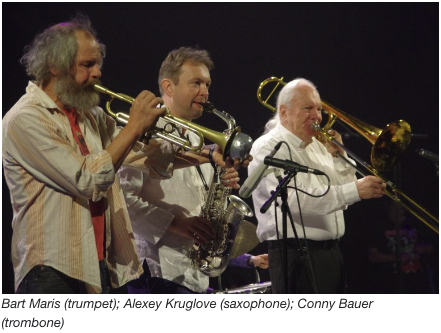
Confirming creative music’s 21st Century expansion in terms of geography and gender, the players were more mixed than a similar band would have been even a quarter century ago. Of the two alto saxophonists involved in the project one, Alexey Kruglov is a Russian man, the other, Masayo Koketsu, a Japanese woman. Trumpeter Bart Maris is Belgian, bassist Kellen Mills is American and are both male, while drummer Lesley Mok is another female. The only German males involved were drummer Achim Krämer and trombonist Conny Bauer, who were also the sole musicians featured from Brötzmann’s era. Brötzmann’s son, guitarist Casper was also present, although he stood away from the others with his contributions mostly reduced to the odd plunk or slash on his strings as well as multiple guitar hero-like poses.
The program itself began with an appropriately Brötzmannian tutti-honking exhale from all the horns, until Bauer’s slippery brass vibrations moved upfront as the individual saxophonists projected multiphonic screams and Maris’ brass pops hung over these interactions. With Kruglov adding to the commotion by blowing through his mouthpiece detached from his horn’s neck, his noises were matched by the trumpeter’s snappy snarls and tongue stops.

As the trombone and saxophonists melded their output into stratospheric shrieks, it was those trumpet snarls that somewhat leavened the intensity. Even though outbursts such as Koketsu’s honks and screams made a distinct impression, the bassist’s thumps and the drummers’ raps ensured that a horizontal pace was maintained. Brief lyrical sound shards could still be heard among the group blowing, along with encouraging yells from band members and the audience. Finally, following Bauer’s prestissimo smears, all the players combined for an ascending explosion before coasting downwards to an abbreviated finale.
The day before the Brözzfrau set, Bauer had already proven that in spite of being almost 81, he’s lost none of his brass power, as he improvised Saturday evening at the enni.eventhalle in a stark duo set with Berlin-based pianist Rieko Okuda. His expositions were as noisy throughout as they were neutral, with busy slide pumps and percussive tongue blasts. Responding partially in kind, the pianist’s keyboard cascades and comping kept the program focused. At the same time, and just as suddenly, she matched the trombonist in adding unexpected motifs: She plucked the piano’s internal strings as Bauer’s tone shudders emphasized his instrument’s metal cladding, or she used elbow and forearm pressure on the keyboard to push his braying tailgate blasts to a more measured interface.
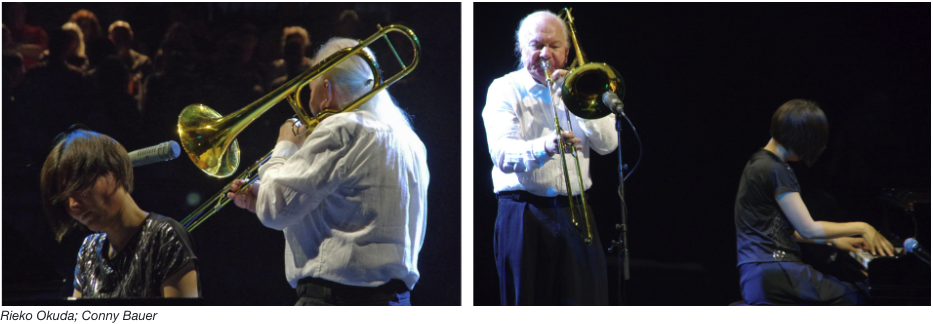
A few hours earlier, drummer Achim Krämer also made his presence felt during a set with a cross-generational, geographically diverse, quintet that included Italian bassist Silvia Bolognesi; Belarusian Oxana Omelchuk manipulating samples and electronics; plus German guitarist Peter Engelhardt and Japanese alto saxophonist Nonoko Yoshida.
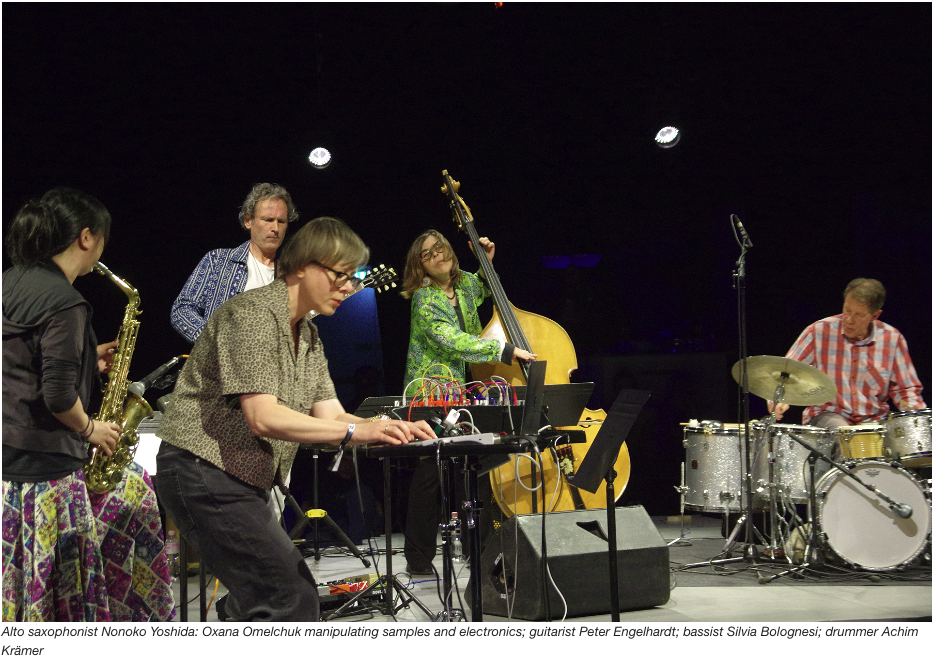
Krämer’s balanced pops and paradiddles plus Bolognesi’s dark steady pulse held on to the performance’s bottom, as the oscillations from Omelchuk’s equipment jiggled and noodled just beneath the surface. Alternating with full-band crescendos, Engelhardt’s string wobbles and surging flanges created theme variations, as did Yoshida’s output that gradually widened and became louder as she moved among puffs and buzzes all the way up to tongue slaps and assertive reed squawks. Not to be outdone, there was an interlude where the drummer exhibited full percussion power, ringing bells and rotating drum sticks on top of his snare while keeping the beat.
Kruglov, who rarely works outside of Russia, had a chance to showcase more of his skills Monday afternoon in Rodelberg, the festival’s open-air stage. Located just off the main market area, it allowed spectators to sprawl in the grass for a clear view of performers on the raised stage, just as long as the weather cooperated.
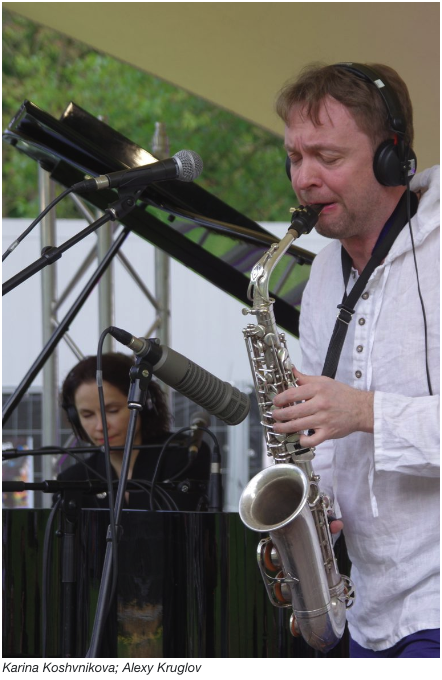
In a duo with pianist/vocalist Karina Koshvnikova, Kruglov had plenty of scope for expansive reed flutters and foreshortened variations, with harsh keyboard clanks echoing beside him.
As Koshvnikova vibrated her vocals from nonsense syllables to scat to lyrical interludes, the saxophonist’s accompaniment ranged from harmonizing a simple melody to projecting resonating nips as he blew through his mouthpiece wrenched from the saxophone neck; huffed air into the saxophone body itself sans ligature and its neck; sourced shrill peeps from a plastic whistle, and sometimes harshly honked through the whistle and the saxophone simultaneously.
Slurred accents and flatulent outbursts also served as a mocking response to the keyboardist when her playing turned as ponderous as some clichéd Russian pop music themes. Eventually, as Koshvnikov relaxed her pianism into a near-lullaby, Kruglov kept the improvisations spiky with unadulterated screams, and spewed out a tense melody that seemed to want to become “The Volga Boatman”.
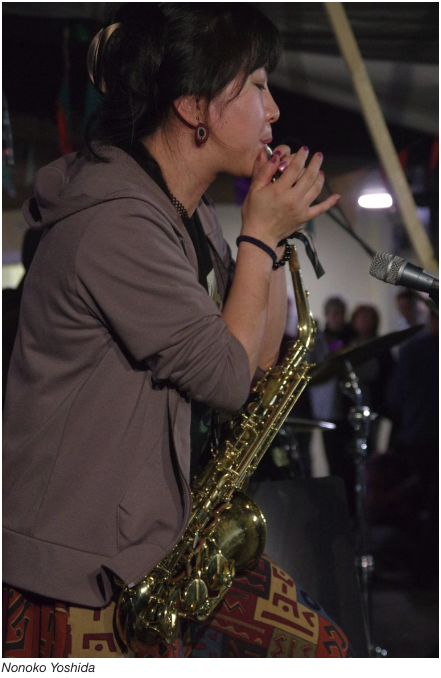
Another saxophonist who made an impression on her own was Japanese altoist Nonoko Yoshida. Not only was she part of that multi-country quintet at the main hall Saturday afternoon, but she also took part in the late-night jam in the schoolyard of the Filder Benden late Friday. Additionally, she and guitarist Loui Yoshigaki had a featured performance in the same schoolyard Monday afternoon.
During her late-night improv with the rebounds and clip clops of drummer Akio Jeimus, a member of the goat band, her strategy was slinky and spiky in equal measures, moving among renal smears and ascending patterns. A sudden pivot into lyricism with a Bop-like rasp lasted only as long as it took to reassert sonic sparks from her split tones and to meet hand-drum shakes.
Two days later in the same open-air schoolyard space, she and Yoshigaki excelled in their mixture of free improv with Rock undercurrents. Using the guitarist’s string slides and stops as a base, Yoshida’s in-and-out breaths set up her solos as she accelerated to tongue slaps and matched her foot pedal sound extensions with vibrating currents from Yoshigaki’s electrified guitar strings.
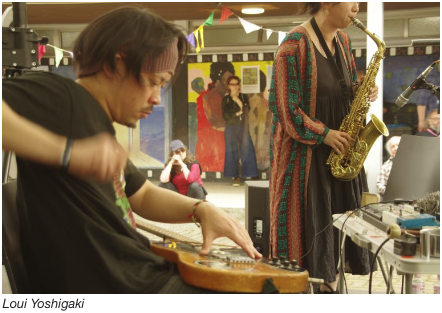
Auguring the drum patterns on a full kit, he performed with the saxophonist as a final duet, Yoshigaki constantly smacked his guitar’s string set full force to create a percussion undercurrent.
While most of the time the saxophonist’s whooshing reed extensions were bolstered by his constant strumming, Yoshigaki’s brief unaccompanied solo created an ambient interlude in the midst of the sound and fury. With resonating dial-twisting licks from the guitarist, other pieces moved closer to Rock, as Yoshida matched string clangs with reed buzzes and tongue slaps, at points inserting a plastic water bottle into her horn’s bell for distinctive tone-strangling power.
When Yoshigaki responded by threading twine between his guitar strings for further tone fragmentation, the result was idiosyncratically distinct.
Another reed stylist, veteran Essen-based alto saxophonist Jan Klare led the raucous and rollicking KIND sextet through a series of his jumping and enthusiastic compositions from the Rodelberg stage Saturday afternoon.
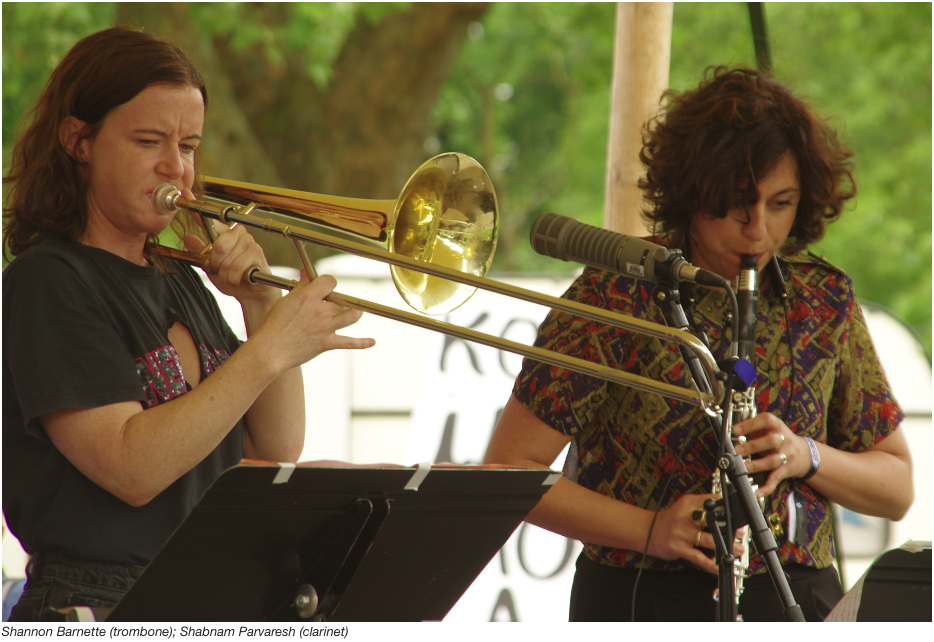
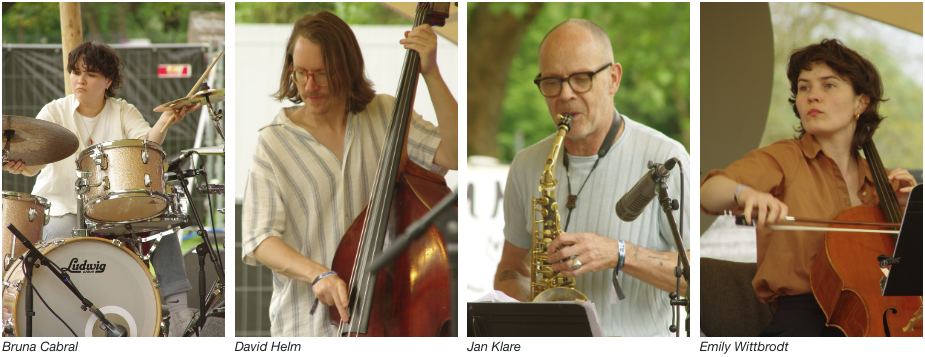
Balancing on the steady but sometimes stiff backbeats of drummer Bruna Cabral, plus concentrated buzzing from the strings of cellist Emily Wittbrodt, and pizzicato or arco accents from bassist David Helm, the convivial tunes sometimes took on circus music aspects. This was mostly expressed by Klare’s vocalized alto saxophone reed asides or his clarion clarinet trills. These evolved in contrapuntal expression with trombonist Shannon Barnett’s warm grace notes and bass clarinetist Shabnam Parvaresh’s studied lowing. Moving among slide-extending brassy flatulence and politer impressionistic effects, the trombonist helped centre the tunes whether they were easygoing or effervescent. Parvaresh’s reed obbligatos were usually thin but effective, especially when responding to the other horns’ overblowing that preserved horizontal momentum alongside foot-tapping fun.
These evolved in contrapuntal expression with trombonist Shannon Barnett’s warm grace notes and bass clarinetist Shabnam Parvaresh’s studied lowing. Moving among slide-extending brassy flatulence and politer impressionistic effects, the trombonist helped centre the tunes whether they were easygoing or effervescent. Parvaresh’s reed obbligatos were usually thin but effective, especially when responding to the other horns’ overblowing that preserved horizontal momentum alongside foot-tapping fun.
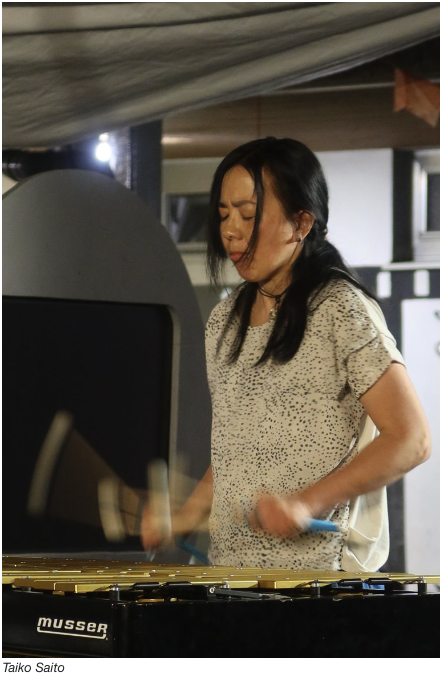
At a previous late-night session in the schoolyard Annex, Australian Barnett demonstrated her brass expertise in a set that depended on narrative color from the shimmies and vibrations of Taiko Saito’s vibraphone. While the Japanese vibes player developed her expressions with a flurry of single strokes that were amplified with motor resonations, Barnett roamed all over the trombone, huffing tones, holding on to a portamento exposition, and using plunger smears and continuous blasts for emotional cries and percussive tonguing.
As it may seem obvious, one of this year’s Moers festival subsets was a focus on Japan. It therefore wasn’t surprising to observe many sets with performances from that country, either using expected Western instruments, or those who played traditional Asian instruments but often experimented with unique musical forms. Among the many Moers concerts featuring koto players, one at enni.eventhalle Friday afternoon stood out.
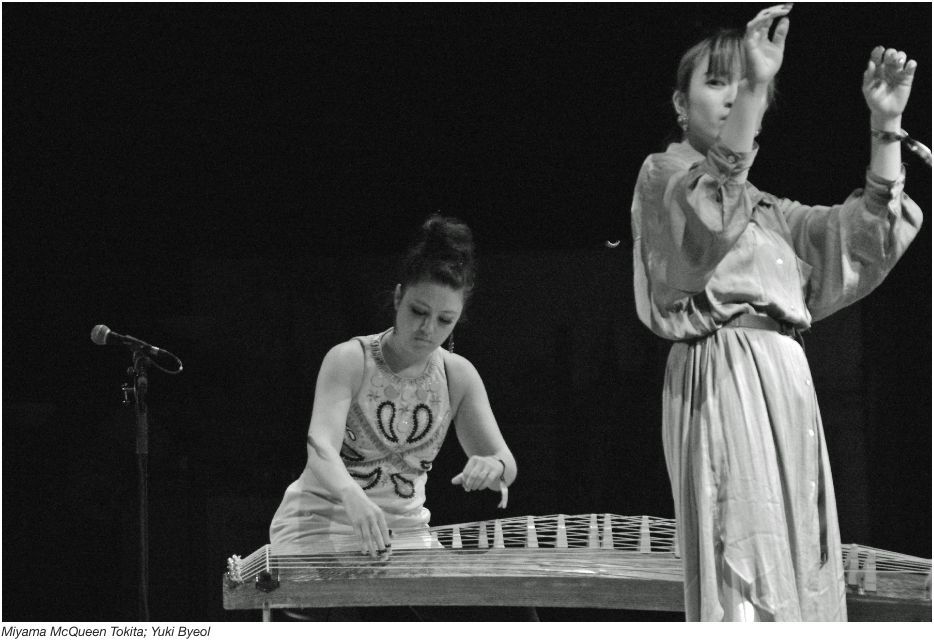
That’s because Australian-Japanese Miyama McQueen Tokita’s amplified plucks, strums and scratches on the koto’s multiple strings were matched with visuals created by Akiko Nakayama projected on the wall overhead and with on stage movements from dancer Yuki Byeol. Wearing Loose-fitting dress pants with a long shirtdress and light shoes, Byeol wasn’t hampered by haberdashery. Seemingly able to effortlessly and separately move various parts of her body at will, the dancer performed while swinging one leg in multiple directions, moonwalking or bowing and gyrating with hands on waist to link her movements with McQueen Tokita’s playing.
Accompaniment moreso than harmonious amplification, the kotoist angled and manipulated her strings in multiple directions, using the resulting woody pops or slippery stops to mark transitions, and latterly added the tinkling of small bells to add lyricism. Warbling Betty-Boop-like vocals backed by low-pitched string stops marked the duo’s finale and confirmation of a singular performance.

Kotos were involved in another departure from traditional Japanese sounds at the main hall the next day when American Zeena Parkins brought her electrified harp to interact with the 21-string bass koto and 13-string regular koto played by Japanese Michiyo Yagi. With extended techniques displayed on all instruments, the cross-pulsed tsunami of sounds moved far past expected string-strumming. With resultant tones alternately expressing the bellicose and the beautiful, creativity was often engendered by Parkins snaking implements among her strings, or covering the strings with plastic wrap to extract distinct timbres when rattled.
Meanwhile, the slides, pops and slides created by Yagi on either instrument also included distinctive tonal pivots when she rubbed a violin bow among the koto’s strings or rapped the instrument on its wood. These characteristic moves confirmed her individuality as well as adding a linear base to the improvisations.

Unlike most of the other Japanese musicians who mixed traditional instruments with more advanced sounds, both of Satoko Fujii’s concerts featured her piano playing and related directly to pure improvised music. Her Sunday afternoon duo with trumpeter Natsuki Tamura in the Fildr Benden’s small auditorium began by expressing long, lyrical sweeps that contrasted smartly with the trumpeter’s brassy shakes and note-bending. It was a definitive demonstration of free music, while her set in the open air Rodelberg on Monday afternoon, with her Tokyo trio of bassist Takashi Sugawa and drummer Ittetsu Takemura was almost pure Jazz.
Seated on a chair at some distance from Fujii’s piano, Tamura began by sounding long lyrical tones that markedly challenged Fujii’s deepening pedal-point explorations. Once her keyboard caresses reach a crescendo however, he turned to mouthpiece sucking and half-valve cries that seemed almost feline.
As the spittle-encrusted brass tones advanced to buzzes, Fujii created contrapuntal responses as she worked a wooden ruler among the piano’s internal strings jolting them to produce a concentrated buzz.
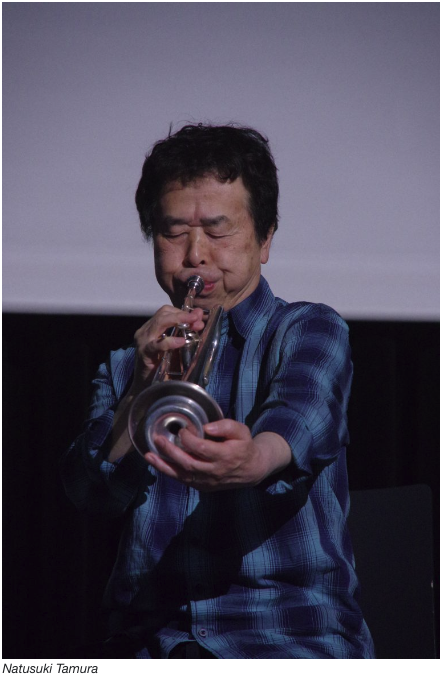
Picking up on that noise with tongue pops and growls, the trumpeter suddenly pivoted to high-pitched bugling yelps as Fujii did the opposite, abruptly showcasing tightly packed glissandi. From then on the musical ping pong match continued with the trumpeter sometimes projecting cup-muted plunger tones and the pianist intensifying tough funereal chording. Parody and lyricism wasn’t absent however.
At one point Tamura seemed to be inserting a half-remembered Tin Pan Alley ditty into his solo. Other times, Fujii appeared to be emphasizing 19th Century Russian orchestrations or at another point broad, clanking Ragtime references. Eventually improvisations from both accelerated to a mélange of scattered brass bites and keyboard slaps, then stopped.
Fujii’s Rodelberg concert evolved in a different fashion considering she was playing as part of a classic Jazz configuration. Moderated piano chording, drum patterning and moderated bass solos characterized the tunes along with expected reprises of the heads. Fujii sometimes produced double and triple rhythms as she dynamically moved from stops to storytelling. As the afternoon wore on the others relaxed as well.
Sugawa emphasized arco buzzing tones and single string pops to realize multiple tempos, while Takemura rang small bells or created rattling rebounds with string pressure. Starting slowly, but often working up to andante tempos, then speeding up to presto with waterfalls of keyboard notes, Fujii at points dived into the piano’s innards to pluck its strings or slap them with a small mallet. This was usually done in tandem with key-stopping. All the while fragile exhibitions of crystal-clear note isolating or meditative chording were her fallback positions on other tunes. With sharp drumbeats ricocheting like fired bullets, the trio finally came to a standstill as thick string pumps and keyboard cascades rolled to an authoritative climax.
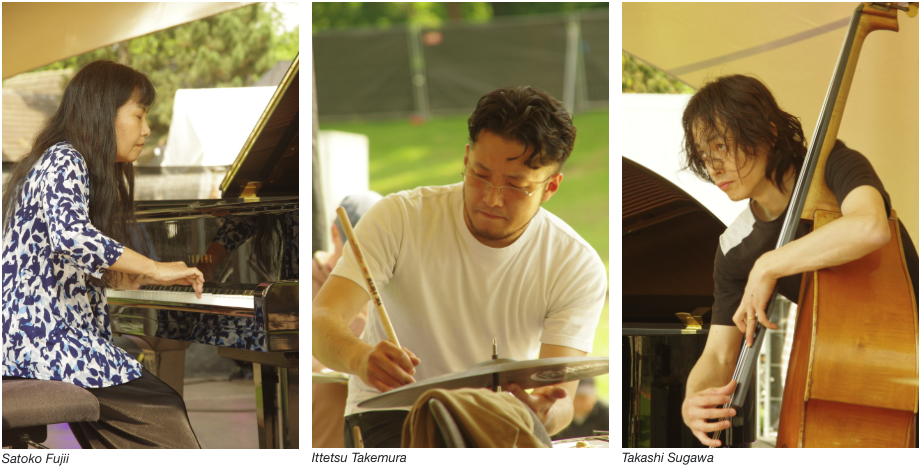
Fujii wasn’t the only pianist featured at Moers 53 however. Two others who made strong showings, coincidentally both at Rodelberg, were Köln-based Austrian pianist Philip Zoubek, with bassist Sebastian Gramss and drummer Erwin Ditzner; and the British quartet of Alexander Hawkins with violinist Julia Brüssel, cellist Emily Wittbrodt and bassist Neil Charles.
Dizzily spearing hard tones from the piano keyboard during his trio’s Sunday afternoon set, Zoubek slugged repetitive chords to the others, which were picked up and amplified by Gramss’ arco rubs and Ditzner’s stentorian pops and cymbal clangs. Frequently the pianist also used synthesizer-sourced smears to color the interchange. While Zoubek was proficient in nonchalantly sliding from Monk-like understatement to lyrical song-form elaborations, this wasn’t a one-man show.
At points Gramss’ textural expression came from vibrating two bows on his strings simultaneously, one horizontal and one vertical, or rhythmically striking the strings with a small stick. Ditzner varied his pulse by using mallets or a short stick on drum tops to create angular beats. None of these barbed asides affected the smooth flow of the trio though, with Zoubek literally taking the interjections in stride as he chugged along, adapting varied strategies for his storytelling. When the proper groove was attained, the three finally slowed down as a steady bass pulse, measured drum slaps and hearty piano comping settled into a concluding drone.
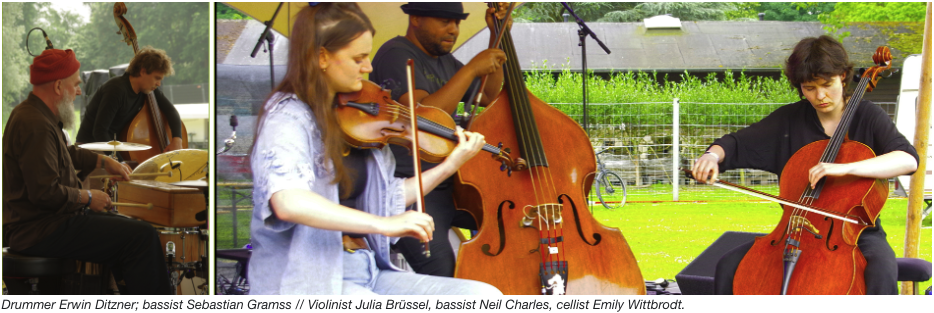
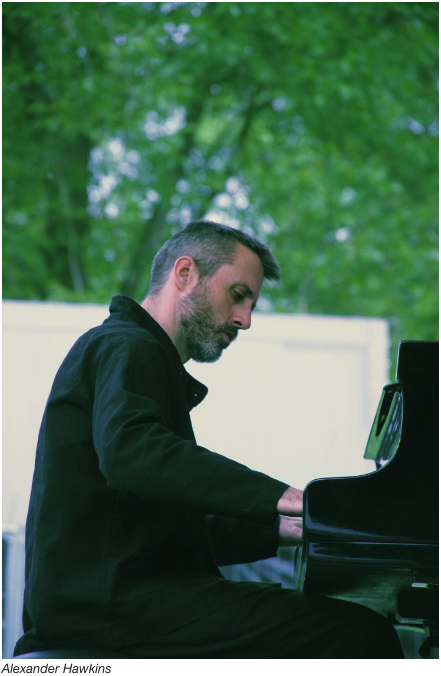
Friday afternoon’s introductory open-air concert was also driven by the piano playing – and some synthesizer color – of Hawkins. But the addition of three string players made for a completely different, if equally memorable, sound than that produced by other piano-centred groups. With the lower-pitched cello and double bass strings dedicated to deepened buzzes and swills, and the violinist contributing minimalist plucks, the pianist advanced storylines with atmospheric echoes and swift pumps. When Charles put sharper points on his accompaniment by turning to spiccato string slices and below the bridge pressure, Brüssel and Wittbrodt together sweetened their variations. Hawkins went the other way, banging and vibrating tremolo chords.
The bassist’s further pivot to Jazz-like woody plucks found Hawkins’ contrapuntal response to be speedy pianism that swept across the keys upping the excitement and emphasizing a swinging groove. Overcoming what had been contrasting timbral discord, the cellist and violinist consolidated their bow plinks and plucks into a buzzing swing rhythm. Eventually a combined narrative was attained by all, which was equal parts lyrical sweeps and rasping interludes.
Pianism writ large was evoked by German keyboardist Stefan Schultze, whose experiments using the textures available from acoustic and player pianos were featured in multiple locations during the festival.
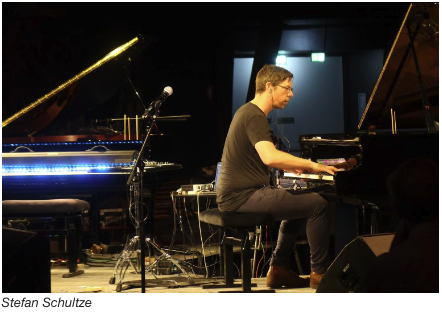
At the enni.eventhalle his live and pre-programmed instrumental textures were extended with an overhead video projections of some of his scores. Schultz’s multi-keyboard musing, tempo and pitch changes were often mirrored by modifications and adjustments in the designs and colors reflected on an overhead screen. Still, due to the nature of the setup where both keyboards’ output encompassed rhythmic clanks, dramatic note clusters as well as flowery interludes, the repeated cadences whether fast, slow or mid-range always seemed to default to clanking Ragtime-like suggestions wavering underneath more modern expositions.
Besides these festival sub-genres, some of the more notable Moers sets were unique unto themselves, often involving idiosyncratic performers and performances, and unexpected instrumental combinations.
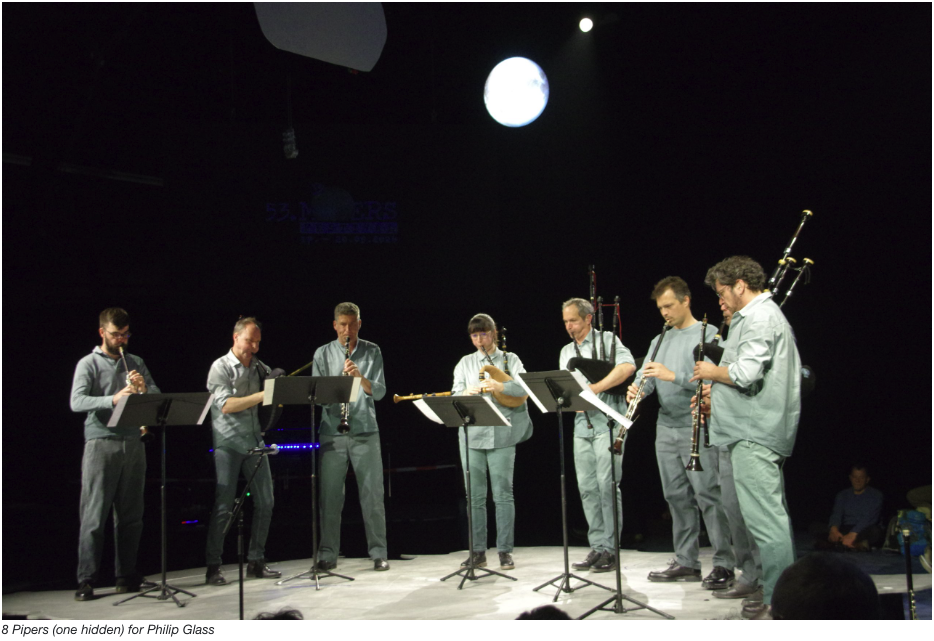
For instance, 8 Pipers for Philip Glass at the main hall Monday evening was exactly as promised. An octet of experienced wind specialists under the direction of French piper Erwan Keravec played an often-changing collection of modern and traditional, mostly Breton bagpipes to approximate the near stative drone of some of the American composer’s compositions. The players also showcased group improvisations with that same sort of interface.
Combining and splitting into various formations, the identically dressed musicians harmonized powerfully as they moved forward and retreated huffing and puffing. Together they used a series of pipes, encompassing ones which resembled oboes, and others with the familiar bagpipe-and-chanter shape. The idea was to project a series of drones and buzzes without singular solos so that spatial echoes and melded vibrations increased the resonating power of the projected sounds. Fascinating in its originality, the drawback was the lack of individualism. Often it appeared as if all eight were consistently outputting a single undivided vibrating tone.
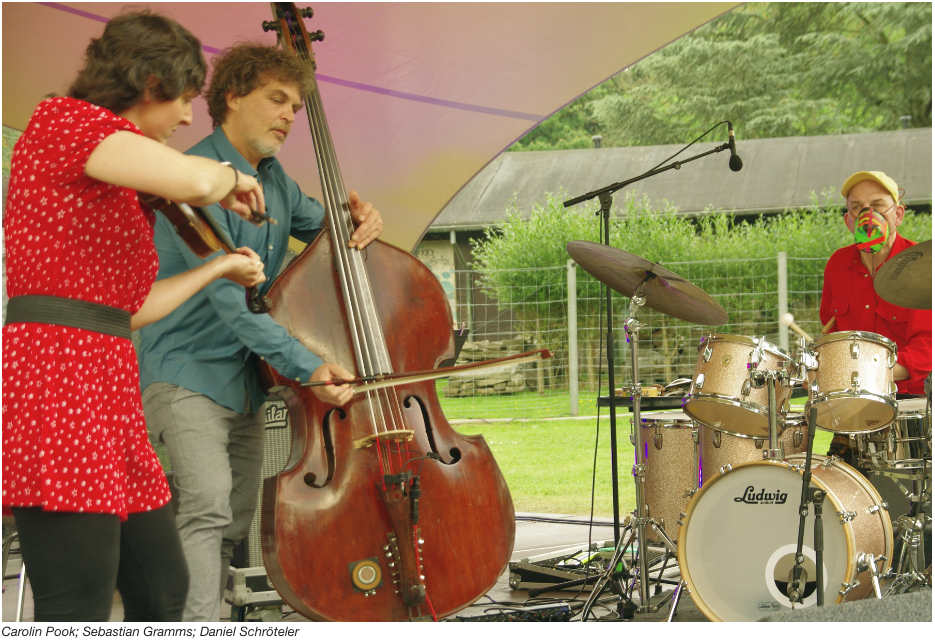
Like Julia Brüssel, another violinist who moved between free improv and free jazz was Carolin Pook, one-third of the all-German Carpool Kino that played at Rodelberg Monday afternoon. Also featured were drummer Daniel Schröteler and bassist Sebastian Gramss, who had been part of Zoubek’s trio.
Pook’s swift sawing and harsh scratches were matched by the bassist’s plucks, intensified by arco strokes utilizing a cross bow or inserting what looked like a lollipop among his strings. Meanwhile Schröteler bopped and smacked his kit as a hint of electronic processing added modernist affiliations to the narrative, as did Gramss’ mid-range string squeezes and below-the-bridge rasps. Eventually though, the trio reached an animated connection, with Gramss seemingly outputting a Motown-like line, Schröteler emphasizing heavy backbeat slaps and Pook sliding her string strategy onto an approximation of swing.
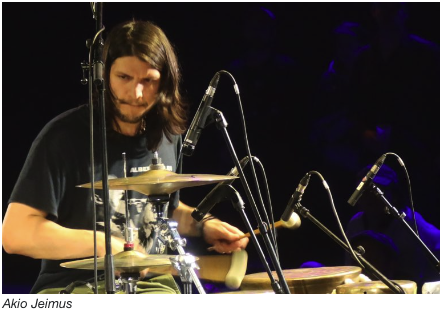
Other groups seemed to use concepts other than pure music to make their points, depending more on spectacle or performance. Japan’s goat [sic] band, which played Saturday evening at the enni.eventhalle produced a variant of unyielding Rock-directed buzzes collectively propelled by alto saxophonist Akihiko Ando, electric bassist Atsumi Tagami, guitarist Koshiro Hino and drummer Akio Jeimus, who had played in a less formal and more improvised fashion during another late-night schoolyard concert.
However most attention was focused on the seemingly endless rhythm variations of Tetsushi Nishikawa, who pummeled what seemed to be taiko drums or a gran casa situated on top of his regular kit. While there was some respite with the occasional reed blat, electronic wiggles or bass bounce, most of the aural real estate was taken up by a solid wall of unbroken backbeats that Nishikawa output. The result was spectacular or numbing depending on one’s point of view.
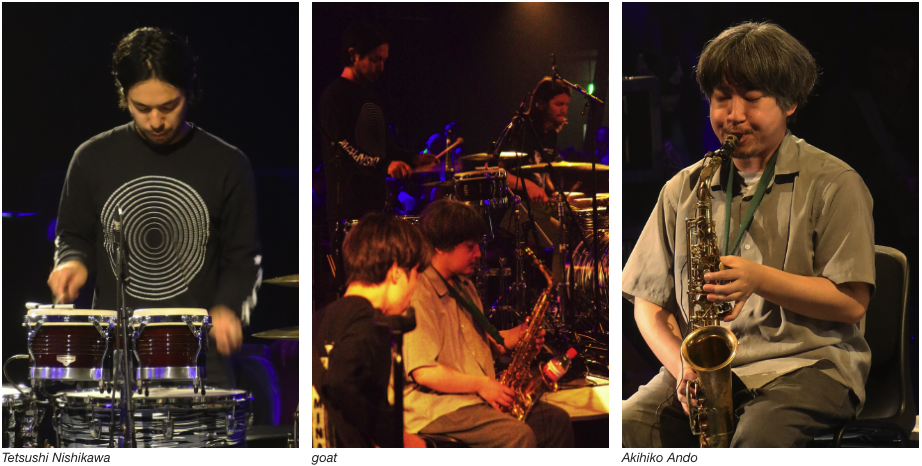
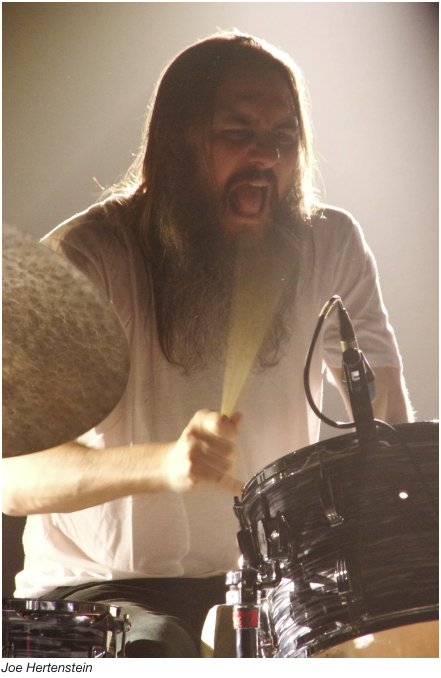
German-drummer-in-New-York Joe Hertenstein’s XCountry Bungalow, which also included Dafna Naphtali’s live processing, Eliad Wagner’s modular synthesizer and Kellen Mills’ bass, came up with some intriguing textures when it played at the same venue later that night.
This was especially true when irregular drum patters or backbeats were contrasted with strident metallic textures from the electronics and strained vocalizing from Naphtali. However the spotlight was literally on American performance artist Daisy Payero. She was the focal point from within a back-lit cloth-walled box in which she gyrated, danced, and emphasized hand motions and other pantomime movements. Her exaggerated or grotesque gestures were so otherworldly and weird as to be fascinating and frightening in equal measure.
Another anomaly, which opened the Moers festival concerts in the main hall Friday night, was a program featuring Namibian composer/vocalist Eslon Hindundu with his Oumwe (Unity) project.
A variant on the operatic programs he has created in the past, it featured the composer singing and playing a handheld African drum backed by 11 German musicians, who aided in performing the rousing but obviously notated score. Occasional solos from string or reed players and a rhythmic underpinning that was hand-clapping, but almost defiantly primitivist didn’t mute its formalism.
Switching among orchestra-conducting and soloing as vocalist and percussionist, Hindundu kept the proceedings moving smartly. An interlude featuring Nambian singer and ukulele player Angelina Tashiya Akawa performing lyrics that sounded much closer to American folk songs than African music, was an unexpected diversion. More spectacular was the entrance of a troupe of barefoot and scantily clad Ju/’hoansi san performers who snake-danced through the audience and onto the raised stage. Lustily gyrating rhythmically while singing in Khoi and Oijinhero, the performers made an indelible impression, although their ethnic songs and movements appeared to be in variance with the more formal program presented by Hindundu and the ensemble.

These were just some of the many concerts presented from morning until late at night in numerous venues throughout the festival grounds and elsewhere in the city of Moers itself. Unfortunately, presenting so many performances, and with some taking place at almost the same time as others but in scattered locations, made it impossible for anyone to experience the program in its entirety.
Yet that was the point of the Moers Festival in its 53rd year: to offer many strands of music to its audience, which it did. As this continues however, and the festival insists on broadening its program well past its Jazz base, it risks losing the definition that has distinguished it from other more pop-oriented gatherings.
Report by Ken Waxman
Photos by Susan O’Connor
Link: https://www.jazzword.com/festivals/moers-at-53-in-2024/ (Abgerufen am 14.08.2024 um 23:33)
